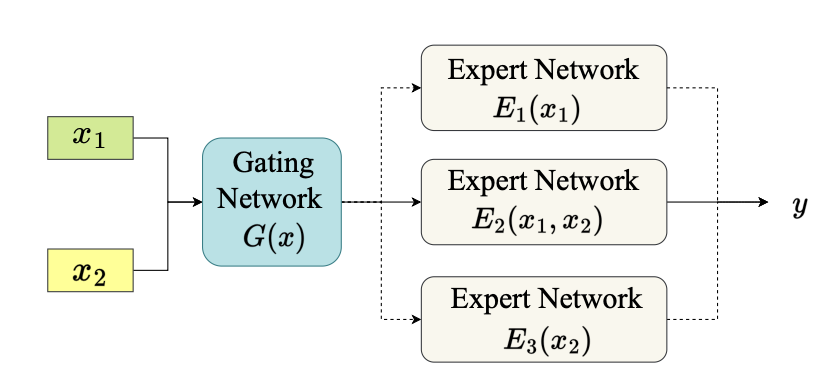Dynamic Multimodal Fusion
Zihui Xue, Radu Marculescu
6th Multi-Modal Learning and Applications Workshop (MULA), CVPR 2023
Task: (1) Movie Genre Classification on MM-IMDB; (2) Sentiment Analysis on CMU-MOSEI
Modality: (1) image, text; (2) video, audio, text
We adapt the Multibench codebase to enable a modality-level DynMM, which makes sample-wise decisions on which modality to adopt.
(1) Download MM-IMDB and CMU-MOSEI data from Multibench.
(2) Clone the Multibench repository.
(3) Copy folders from ModalityDynMM to MultiBench
Step I: train expert networks, model checkpoints will be saved in ./log/imdb and ./log/mosei.
### MM-IMDB
# Expert network 1: text
python examples/multimedia/imdb_uni.py
# Expert network 2: image + text late fusion
python examples/multimedia/imdb_mm.py --fuse 1
### CMU-MOSEI
# Expert network 1: text transformer
python examples/affect/affect_uni.py
# Expert network 2: video + audio + text transformer late fusion
python examples/multimedia/imdb_mm.py --fusion 3Step II: train modality-level DynMM
### MM-IMDB
python examples/multimedia/imdb_dyn.py (--freeze) (--hard-gate) --reg $reg_loss_ratio
### CMU-MOSEI
python examples/affect/affect_dyn.py (--freeze) (--hard-gate) --reg $reg_loss_ratiofreeze controls whether to freeze the weights of the expert networks during training, hard-gate decides whether to use hard gates or soft gates during training, and reg_loss_ratio corresponds to lambda in Equation (1) of the paper.
Task: Indoor Semantic Segmentation on NYU Depth V2
Modality: RGB images, depth images
We adapt the ESANet codebase to design a fusion-level DynMM, enabling more fine-grained input-dependent decision making during the inference process.
Follow ESANet to build conda environments and process data
# change the directory
cd FusionDynMM
# set up the envrionment
conda env create -f rgbd_segmentation.yaml
conda activate rgbd_segmentation
# process data
cd src/datasets/nyuv2
pip install -r ./requirements.txt
python prepare_dataset.py ../../../datasets/nyuv2
Training logs and model checkpoints can be found here. Download them to skip the training process and proceed directly to the evaluation step.
General training command:
python train.py --dynamic --global-gate --loss-ratio $loss_ratio \
--temp $start_temp --end_temp $end_temp \
--epoch_ini $epoch_ini --epoch_hard $epoch_hard Best config (temp1-0.001-loss1e-4-inifromhard from training logs):
python train.py --dynamic --global-gate --loss-ratio 1e-4 --eval-every 1 \
--finetune results/nyuv2/hard-loss1e-4/ckpt_best.pth \
--temp 1.0 --end-temp 0.001 \
--epoch_ini 0 --epoch_hard 500 (1) Regular setting (Table 3 in the paper)
# Baseline (static ESANet), mIoU = 50.28
python eval.py --dynamic --global-gate --baseline --hard \
--ckpt_path results/nyuv2/baseline/ckpt_best.pth
# Ours (Fusion-level DynMM), mIoU = 50.98 along with fewer computations
python eval.py --dynamic --global-gate --hard \
--ckpt_path results/nyuv2/temp1-0.001-loss1e-4-inifromhard/ckpt_best.pth (2) Robustness results (Fig. 6-7 in the paper)
Add random Gaussian noise to RGB / depth images:
# Baseline (static ESANet)
python eval.py --dynamic --global-gate --baseline --hard \
--num_runs 10 --mode $mode --noise $noise_level \
--ckpt_path results/nyuv2/baseline/ckpt_best.pth
# Ours (Fusion-level DynMM)
python eval.py --dynamic --global-gate --hard \
--num_runs 10 --mode $mode --noise $noise_level \
--ckpt_path results/nyuv2/temp1-0.001-loss1e-4-inifromhard/ckpt_best.pth mode: 0-only add noise to RGB images; 1-only add noise to depth images; 2-add noise to both modalities
noise_level: 0-1, control the variance of Gaussian noise
If you find this repository useful, consider citing our paper:
@inproceedings{xue2022dynamic,
title={Dynamic multimodal fusion},
author={Xue, Zihui and Marculescu, Radu},
booktitle={Multi-Modal Learning and Applications Workshop (MULA), CVPR},
year={2023}
}

